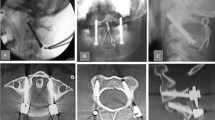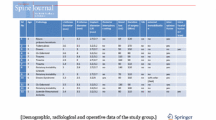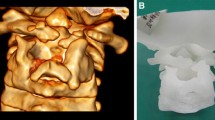Abstract
There are several treatment options for rigid fixation at C1–C2 including Brooks and Gallie type wired fusions and C1–2 transarticular screws. The use of a Goel–Harms type fusion, a construct with C1 lateral mass screws and C2 pedicle screws, has not been extensively described in pediatric patients. Here, we describe its relatively safe and effective use for treating pediatric patients by retrospective chart review of patients treated by the senior author for atlantoaxial instability with a Goel–Harms-type constructs during a 3-year period (2005–2007). Six patients were treated using Goel–Harms-type constructs. Five patients were treated utilizing a construct containing C1 lateral mass screws and C2 pedicle screws; one patient was treated using construct containing C1 lateral mass screws and C2 trans-laminar screws. The patients ranged in age from 7 to 17 years old (mean 12.7). All patients had findings of an os odontoideum on CT scans and three of the six patients had T2 hyperintensity on MRI. Three of the six patients presented with transient neurologic deficits: quadraplegia in two patients and paresthesias in two patients. In each patient C1 lateral mass and C2 screws were placed and the subluxation was reduced to attain an anatomical alignment. No bone grafts were harvested from the iliac crest or rib. Local morsalized bone and sub-occipital skull graft was used. All patients tolerated the procedure well and were discharged home on post-operative day 3–4. The patients wore a hard cervical collar and no halo-vests were needed. All patients had solid fusion constructs and normal alignment on post-operative imaging studies performed on average 14 months post-operatively (range: 7–29). The results demonstrated that Goel–Harms fusions are a relatively safe and effective method of treating pediatric patients with atlantoaxial instability and are not dependent on vertebral anatomy or an intact ring of C1. Follow-up visits and studies in this limited series of patients demonstrated solid fusion constructs and anatomical alignment in all patients treated.





Similar content being viewed by others
References
Anderson RC, Kan P, Gluf WM, Brockmeyer DL (2006) Long-term maintenance of cervical alignment after occipitocervical and atlantoaxial screw fixation in young children. J Neurosurg 105:55–61
Anderson RCE, Ragel BT, Bohman LE, Brockmeyer DL (2007) Selection of a rigid internal fixation construct for stabilization at the craniovertebral junction in pediatric patients. J Neurosurg 107:36–42
Arrington ED, Smith WJ, Chambers HG, Bucknell AL, Davino NA (1996) Complications of iliac crest bone graft harvesting. Clin Orthop Relat Res (329):300–309. doi:10.1097/00003086-199608000-00037
Banwart JC, Asher MA, Hassanein RS (1995) Iliac crest bone graft harvest donor site morbidity. A statistical evaluation. Spine 20:1055–1060. doi:10.1097/00007632-199505000-00012
Brockmeyer DL, Apfelbaum RI (1999) A new occipitocervical fusion construct in pediatric patients with occipitocervical instability. Technical note. J Neurosurg 90:271–275
Brockmeyer DL, York JE, Apfelbaum RI (2000) Anatomical suitability of C1–2 transarticular screw placement in pediatric patients. J Neurosurg 92:7–11
Brockmeyer DL (2002) A bone and cable girth-hitch technique for atlantoaxial fusion in pediatric patients. Technical note. J Neurosurg 97:400–402
Brooks AL, Jenkins EB (1978) Atlanto-axial arthrodesis by the wedge compression method. J Bone Joint Surg Am 60:279–284
Chan K, Resnick D, Pathria M, Jacobson J (2001) Pelvic instability after bone graft harvesting from posterior iliac crest: report of nine patients. Skeletal Radiol 30:278–281. doi:10.1007/s002560100344
Coe JD, Warden KE, Sutterlin CE 3rd, McAfee PC (1989) Biomechanical evaluation of cervical spinal stabilization methods in a human cadaveric model. Spine 14:1122–1131. doi:10.1097/00007632-198910000-00016
Crisco JJ 3rd, Panjabi MM, Oda T, Grob D, Dvorak J (1991) Bone graft translation of four upper cervical spine fixation techniques in a cadaveric model. J Orthop Res 9:835–846. doi:10.1002/jor.1100090609
Dalinka MK, Rosenbaum AE, Van Houten F (1972) Congenital absence of the posterior arch of the atlas. Radiology 103:581–583
Dickman CA, Sonntag VK (1998) Posterior C1–C2 transarticular screw fixation for atlantoaxial arthrodesis. Neurosurgery 43:275–280. doi:10.1097/00006123-199808000-00056
Fraser AB, Sen C, Casden AM, Catalano PJ, Post KD (1994) Cervical transdural intramedullary migration of a sublaminar wire A complication of cervical fixation. Spine 19:456–459
Galindo MJ Jr, Francis WR (1983) Atlantal fracture in a child through congenital anterior and posterior arch defects. A case report. Clin Orthop Relat Res (178):220–222
Gallie W (1939) Fractures and dislocations of the cervical spine. Am J Surg 46:495–499. doi:10.1016/S0002-9610(39)90309-0
Geremia GK, Kim KS, Cerullo L, Calenoff L (1985) Complications of sublaminar wiring. Surg Neurol 23:629–635. doi:10.1016/0090-3019(85)90017-5
Gluf WM, Brockmeyer DL (2005) Atlantoaxial transarticular screw fixation: a review of surgical indications, fusion rate, complications, and lessons learned in 67 pediatric patients. J Neurosurg Spine 2:164–169
Gluf WM, Schmidt MH, Appelbaum RI (2005) Atlantoaxial transarticular screw fixation: a review of surgical indications, fusion rate, complications, and lessons learned in 191 adult patients. J Neurosurg Spine 2:155–163
Goel A, Laheri V (1994) Plate and screw fixation for atlanto-axial subluxation. Acta Neurochir (Wien) 129:47–53. doi:10.1007/BF01400872
Grob D, Crisco JJ 3rd, Panjabi MM, Wang P, Dvorak J (1992) Biomechanical evaluation of four different posterior atlantoaxial fixation techniques. Spine 17:480–490. doi:10.1097/00007632-199205000-00003
Hamad MM, Majeed SA (1989) Incisional hernia through iliac crest defects. A report of three cases with a review of the literature. Arch Orthop Trauma Surg 108:383–385. doi:10.1007/BF00932452
Harms J, Melcher RP (2001) Posterior C1–C2 fusion with polyaxial screw and rod fixation. Spine 26:2467–2471. doi:10.1097/00007632-200111150-00014
Henriques T, Cunningham BW, Olerud C, Shimamoto N, Lee GA, Larsson S, McAfee PA (2000) Biomechanical comparison of five different atlantoaxial posterior fixation techniques. Spine 25:2877–2883. doi:10.1097/00007632-200011150-00007
Jea A, Taylor MD, Dirks PB, Kulkarni AV, Rutka JT, Drake JM (2007) Incorporation of C-1 lateral mass screws in occipitocervical and atlantoaxial fusions for children 8 years of age or younger. Technical note. J Neurosurg 107:178–183. doi:10.3171/JNS-07/07/0178
Jun BY (1998) Anatomic study for ideal and safe posterior C1–C2 transarticular screw fixation. Spine 23:1703–1707. doi:10.1097/00007632-199808010-00018
Lapsiwala SB, Anderson PA, Oza A, Resnick DK (2006) Biomechanical comparison of four C1 to C2 rigid fixative techniques: anterior transarticular, posterior transarticular, C1 to C2 pedicle, and C1 to C2 intralaminar screws. Neurosurgery 58:516–521
Leonard J, Wright N (2006) Pediatric atlantoaxial fixation with bilateral, crossing C-2 translaminar screws. Technical note. J Neurosurg 104:59–63
Lowry DW, Pollack IF, Clyde B, Albright AL, Adelson PD (1997) Upper cervical spine fusion in the pediatric population. J Neurosurg 87:671–676
Lundy DW, Murray HH (1997) Neurological deterioration after posterior wiring of the cervical spine. J Bone Joint Surg Br 79:948–951. doi:10.1302/0301-620X.79B6.7923
Madawi AA, Casey AT, Solanki GA, Tuite G, Veres R, Crockard HA (1997) Radiological and anatomical evaluation of the atlantoaxial transarticular screw fixation technique. J Neurosurg 86:961–968
Mandel IM, Kambach BJ, Petersilge CA, Johnstone B, Yoo JU (2000) Morphologic considerations of C2 isthmus dimensions for the placement of transarticular screws. Spine 25:1542–1547. doi:10.1097/00007632-200006150-00014
Martich V, Ben-Ami T, Yousefzadeh DK, Roizen NJ (1992) Hypoplastic posterior arch of C-1 in children with Down syndrome: a double jeopardy. Radiology 183:125–128
McRae DL (1960) The significance of abnormalities of the cervical spine. Am J Roentgenol Radium Ther Nucl Med 84:15–17
Melcher RP, Puttlitz CM, Kleinstueck FS, Lotz JC, Harms J, Bradford DS (2002) Biomechanical testing of posterior atlantoaxial fixation techniques. Spine 27:2435–2440. doi:10.1097/00007632-200211150-00004
Motateanu M, Gudinchet F, Sarraj H, Schnyder P (1991) Case report 665 congenital absence of posterior arch of atlas. Skeletal Radiol 20:231–232. doi:10.1007/BF00241677
Paramore CG, Dickman CA, Sonntag VK (1996) The anatomical suitability of the C1–2 complex for transarticular screw fixation. J Neurosurg 85:221–224
Porchet F, Jaques B (1996) Unusual complications at iliac crest bone graft donor site: experience with two cases. Neurosurgery 39:856–859. doi:10.1097/00006123-199610000-00043
Rahimi SY, Stevens EA, Yeh DJ, Flannery AM, Choudhri HF, Lee MR (2003) Treatment of atlantoaxial instability in pediatric patients. Neurosurg Focus 15:15. doi:10.3171/foc.2003.15.6.7
Schrader WC, Bethem D, Scerbin V (1988) The chronic local effects of sublaminar wires. An animal model. Spine 13:499–502. doi:10.1097/00007632-198805000-00012
Smith MD, Phillips WA, Hensinger RN (1991) Complications of fusion to the upper cervical spine. Spine 16:702–705. doi:10.1097/00007632-199107000-00002
Smith MD, Kotzar G, Yoo J, Bohlman H (1993) A biomechanical analysis of atlantoaxial stabilization methods using a bovine model. C1/C2 fixation analysis. Clin Orthop Relat Res 290:285–295
Author information
Authors and Affiliations
Corresponding author
Rights and permissions
About this article
Cite this article
Heuer, G.G., Hardesty, D.A., Bhowmick, D.A. et al. Treatment of pediatric atlantoaxial instability with traditional and modified Goel–Harms fusion constructs. Eur Spine J 18, 884–892 (2009). https://doi.org/10.1007/s00586-009-0969-x
Received:
Revised:
Accepted:
Published:
Issue Date:
DOI: https://doi.org/10.1007/s00586-009-0969-x




